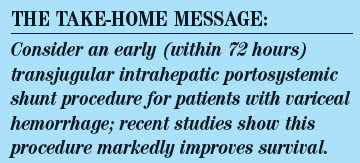What’s The “Take Home”?- Answer
CORRECT ANSWER: A
Variceal hemorrhage is a common complication of the portal hypertension associated with chronic liver disease. It produces considerable morbidity and can be lethal.
This entity has been extensively studied, and management has improved over the past years. Nonetheless, firm data demonstrate that:
- Variceal hemorrhage develops in 25% to 35% of patients with cirrhosis.
- Variceal bleeding accounts for more than 75% of upper GI bleeding episodes in such patients.
- The acute mortality associated with a variceal bleeding episode may approach 30%.
- Bleeding recurs in up to 60% of patients within 1 year.
- Variceal bleeding is a risk factor for mortality in patients with cirrhosis; 1-year survival ranges from 32% to 80%.1,2

Currently, there are 3 temporal approaches to variceal hemorrhage:
- Primary prevention strategies are used in patients who have documented varices that have not yet bled.
- Actively bleeding varices require immediate attention.
- Secondary prevention strategies are used in patients who have survived acute variceal hemorrhage.
The current first-line preventive therapy consists of β-blockers alone or in combination with nitrates, which reduce portal pressure and thus variceal pressure as well. When hepatic vein pressures are lowered to less than 12 mm Hg or are reduced by 20% of the baseline measurement, the incidence of hemorrhage is markedly reduced.3 β-Blockers and nitrates (choice D) can lower hepatic vein pressures to this degree in at least some patients and typically reduce the incidence of bleeding by about 50%.4 They remain the first choice in patients for whom they are not contraindicated. Pharmacological prophylaxis is at least as effective as sclerotherapy (choice C) and shunt surgery (choice B) and is far more cost-effective.5 However, this patient has actively bleeding varices; thus, choice D is incorrect.
Octreotide (choice E) is a synthetic vasopressin that produces vasoconstriction in the splanchnic bed, which lowers portal pressure and thus stops active variceal bleeding in 80% of patients.2,6 Because it can be initiated urgently and without need for specialized endoscopic or radiological facilities and personnel, octreotide is a firstline therapy for active variceal bleeding and indeed was used in this patient. However, its short half-life and intravenous route make it unsuitable for long-term management. Moreover, for definitive treatment, octreotide must be followed by sclerotherapy or band ligation.
A TIPS procedure (choice A) involves placement of a stent that connects a hepatic vein and a large branch of the portal system. Successful TIPS procedures result in hemodynamic improvements comparable to those achieved with surgical shunt placement (choice B), and they are associated with far less cost and acute morbidity and mortality. Because worsening hepatic encephalopathy and shunt occlusion are common complications, TIPS has been reserved for patients with recurrent variceal bleeding and those with refractory acute bleeding. However, more recent studies have shown improved survival when TIPS is used early (within 72 hours) in patients who have Child-Pugh class B cirrhosis with active variceal bleeding or who have class C cirrhosis.1,2,7
In the most recent study, 63 patients were randomized to either early (within 72 hours) TIPS or traditional medical/endoscopic management, with TIPS reserved for either continued active hemorrhage or rebleeding.2,7 The results were striking: early TIPS was associated with significant reductions in failure to control bleeding or rebleeding (97% vs 50% with traditional management) and in mortality at 12 months (86% vs 61% with traditional management). There was no increase in morbidity or mortality from liver failure or encephalopathy in the early TIPS group. Although confirmation is required, these results suggest an alteration in the natural history of variceal hemorrhage in patients with Child-Pugh class B or C cirrhosis, which will affect acute management.
Outcome of this case. The patient underwent an uneventful TIPS procedure on the third day. There was no rebleeding or evidence of encephalopathy. He is doing well and is back at work 4 months after discharge.
1. Garcia-Tsao G, Bosch J. Management of varices and variceal hemorrhage in cirrhosis. N Engl J Med. 2010;362:823-832.
2. García-Pagán JC, Caca K, Burean C, et al; Early TIPS (Transjusgular Intrahepatic Portosystemic Shunt) Cooperative Study Group. Early use of TIPS in patients with cirrhosis and variceal bleeding. N Engl J Med. 2010;362:2370-2379.
3. Villanueva C, Balanzó J, Novella MT, et al. Nadolol plus isosorbide mononitrate compared with slcerotherapy for the prevention of variceal rebleeding. N Engl J Med. 1996;334:1624-1629.
4. Villanueva C, Miñana J, Ortiz J, et al. Endoscopic ligation compared with combined treatment with nadolol isosorbide mononitrate to prevent recurrent variceal bleeding. N Engl J Med. 2001;345:647-655.
5. Teran JC, Imperiale TF, Mullen KD, et al. Primary prophylaxis of variceal bleeding in cirrhosis: a cost-effective analysis. Gastroenterology. 1997;112:473-482.
6. Besson J, Ingrand P, Person B, et al. Sclerotherapy with or without octreotide for acute variceal bleeding. N Engl J Med. 1995;333:555-560.
7. Afdhal NH, Curry MP. Early TIPS to improve survival in acute variceal bleeding. N Engl J Med. 2010;362:2421-2422.


